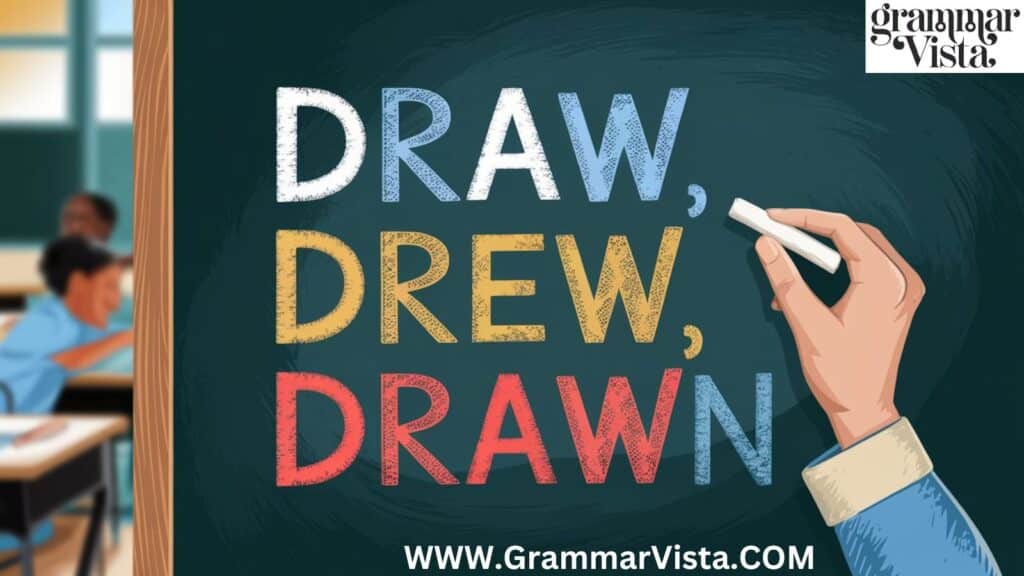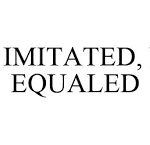Ever found yourself scratching your head over whether to use “drew” or “drawn” when talking about the past tense of draw? You’re not alone! This common conundrum trips up even seasoned English speakers. Let’s dive into the nitty-gritty of these verb tenses and clear up the confusion once and for all.
The Basics: Draw, Drew, and Drawn
First things first: “draw” is an irregular verb. This means it doesn’t follow the typical -ed ending rule for past tense forms. Instead, it has unique forms for different tenses:
- Draw (present tense)
- Drew (simple past)
- Drawn (past participle)
Understanding these forms is crucial for mastering English usage and nailing your verb tenses.
When to Use Drew (Simple Past)
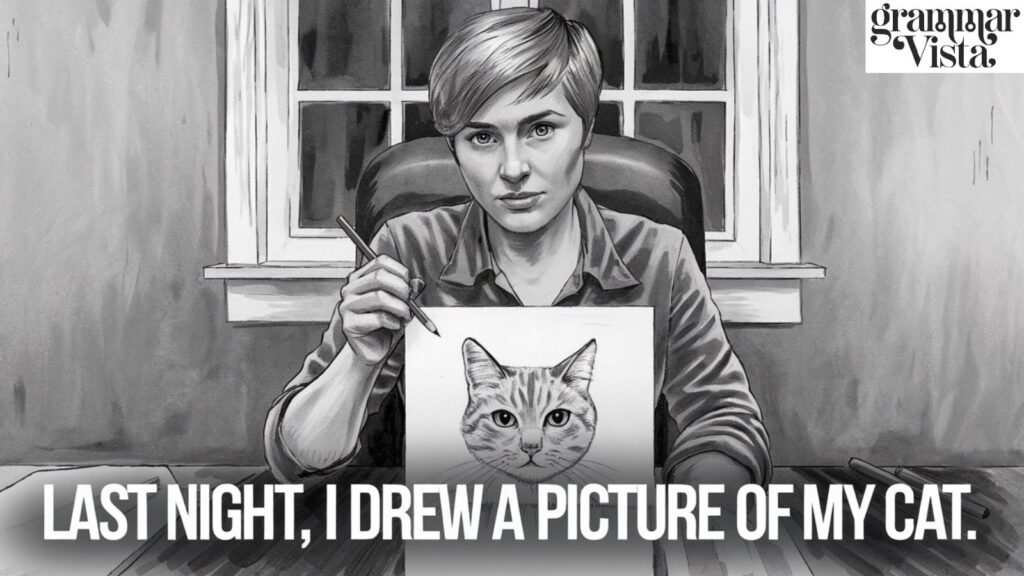
“Drew” is the simple past form of “draw.” You’ll use it when talking about a completed action in the past. For example:
- Last night, I drew a picture of my cat.
- The artist drew sketches of the cityscape.
- She drew inspiration from nature for her latest work.
In these cases, the action of drawing is finished and occurred at a specific time in the past. It’s straightforward and doesn’t involve any helping verbs.
Read More about Business’ or Business’s?
When to Use Drawn (Past Participle)
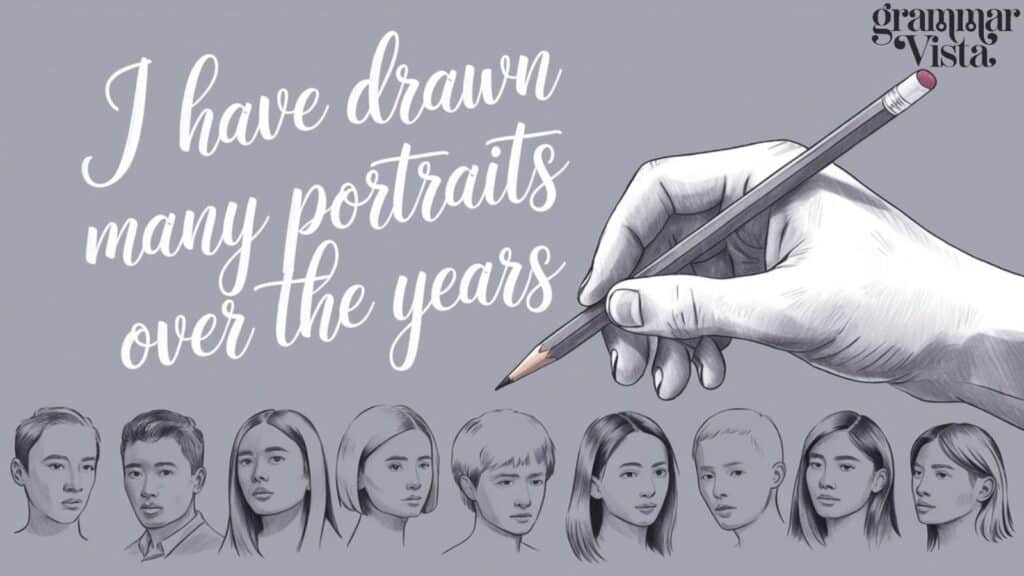
“Drawn” is the past participle form of “draw.” You’ll typically see it used with helping verbs in perfect tenses or in passive voice constructions. For instance:
- I have drawn many portraits over the years.
- The blueprints had been drawn before the meeting.
- The curtains were drawn to block out the sunlight.
Here, “drawn” works with other verbs to create more complex tense structures.
Confusing Scenarios and How to Handle Them
Scenario 1: Describing a Past Action
Imagine you’re telling a friend about your art class yesterday. You might say:
“In class, I drew a still life of fruit.”
Here, “drew” is correct because it’s a simple past action. You’re describing a completed event in the past.
Scenario 2: Talking About Completed Actions with Present Impact
Now, let’s say you’re discussing your portfolio with a potential employer:
“I’ve drawn over 100 portraits in my career.”
In this case, “drawn” is right because you’re using the present perfect tense, which uses the past participle.
Scenario 3: Passive Voice in the Past
Consider a situation where you’re describing an old map:
“The map was drawn by ancient explorers.”
“Drawn” is correct here because it’s used in a passive voice construction.
You might be interested in Story’s or Stories’ or Stories?
Common Mistakes to Avoid

- Mixing up drew and drawn in simple past contexts
Incorrect: “She drawn a beautiful landscape yesterday.”
Correct: “She drew a beautiful landscape yesterday.” - Using drew in perfect tenses
Incorrect: “I have drew many diagrams for this project.”
Correct: “I have drawn many diagrams for this project.” - Confusing draw and drew in the present tense
Incorrect: “He drew pictures every day.” (if you mean it’s a habitual action)
Correct: “He draws pictures every day.”
The Importance of Context in English Grammar
Understanding the grammatical context is key to using “drew” and “drawn” correctly. The surrounding words and the intended meaning play a crucial role in determining which form to use. Let’s explore some tense examples to illustrate this:
- Present tense: “I draw a new sketch every day.” (habitual action)
- Simple past: “Yesterday, I drew a portrait of my grandmother.” (completed past action)
- Present perfect: “I have drawn many different animals over the years.” (past action with present relevance)
- Past perfect: “By the time the exhibit opened, I had drawn twenty pieces.” (past action completed before another past action)
Each of these examples showcases a different tense structure, highlighting how the context shapes our choice between “draw,” “drew,” and “drawn.”
Beyond Draw: Other Commonly Confused Verb Forms
The draw/drew/drawn conundrum isn’t unique. Many irregular verbs in English pose similar challenges. Here are a few more to watch out for:
- Go/Went/Gone
- Sing/Sang/Sung
- Drink/Drank/Drunk
- Swim/Swam/Swum
Like “draw,” these verbs have distinct forms for simple past and past participle uses. Mastering these forms is crucial for achieving fluency and avoiding common pitfalls in English usage.
The Art of Drawing in Language
Now that we’ve cleared up the grammatical rules, let’s have some fun with the verb “draw” in various contexts. After all, language is as much about creativity as it is about correctness!
Drawing Inspiration
Artists often say they draw inspiration from the world around them. In the past, great masters drew from nature, mythology, and human emotions. Today, contemporary artists have drawn upon a vast array of sources, from technology to social issues.
Drawing Conclusions
In academic and professional settings, we frequently talk about drawing conclusions. Researchers draw inferences from data, detectives drew conclusions from evidence, and over time, historians have drawn new interpretations of past events.
Drawing the Line
Sometimes, we need to set boundaries. You might say, “I draw the line at working weekends.” In a heated argument, someone might declare, “That’s where I drew the line!” Or in reflecting on past experiences: “I’ve drawn lines in my relationships to maintain healthy boundaries.”
Practical Tips for Mastering Draw/Drew/Drawn
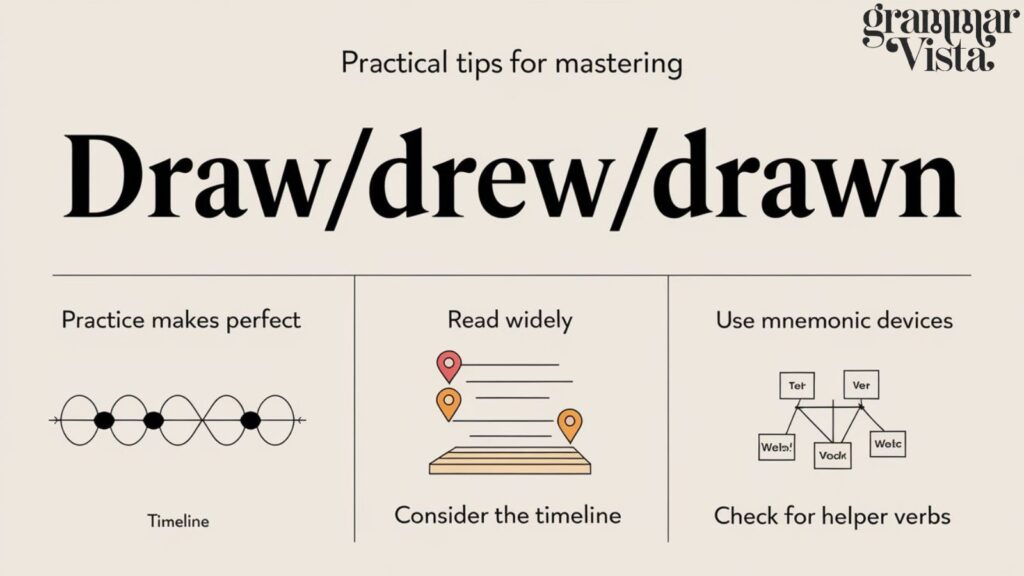
- Practice makes perfect: Create your own example sentences using draw, drew, and drawn in various contexts.
- Read widely: Exposure to good writing will help you internalize correct usage.
- Use mnemonic devices: For instance, “I drew in the past, but now it’s done and drawn.”
- Consider the timeline: Is the action completed in the past (drew), or does it have current relevance (drawn)?
- Check for helper verbs: If you see have, has, or had before the verb, you’ll likely need “drawn.”
The Evolution of ‘Draw’ in English
The verb “draw” has a rich history in the English language. Its roots draw from the Old English “dragan,” meaning to drag, pull, or draw. Over centuries, its meaning expanded to include creating pictures, attracting attention, and even withdrawing money.
In Middle English, people drew water from wells, drew swords in battle, and drew lots to make decisions. By the time Modern English rolled around, artists had drawn masterpieces, mathematicians had drawn complex diagrams, and writers had drawn characters that would captivate readers for generations.
Conclusion: Mastering the Art of Verb Tenses
Understanding the difference between “drew” and “drawn” is more than just a grammar exercise—it’s part of the broader tapestry of language mastery. By grasping these nuances, you’re not just learning rules; you’re gaining the tools to express yourself with precision and clarity.
Remember, language is alive and ever-evolving. While we strive for correctness, the ultimate goal is effective communication. So whether you’re drawing a picture, have drawn a conclusion, or drew inspiration from this article, keep practicing and exploring the rich world of English verbs.
Read More grammar lessons on GrammarVista
As you continue your language journey, don’t be afraid to make mistakes. Every error is an opportunity to learn and grow. Soon enough, you’ll find yourself navigating verb tenses with the confidence of a seasoned linguist, drawing admiration from native speakers and fellow language learners alike.
So go forth and conquer those tricky verbs! Whether you’re writing, speaking, or simply pondering the intricacies of English grammar, may your language skills continue to flourish and your communication always hit the mark.

